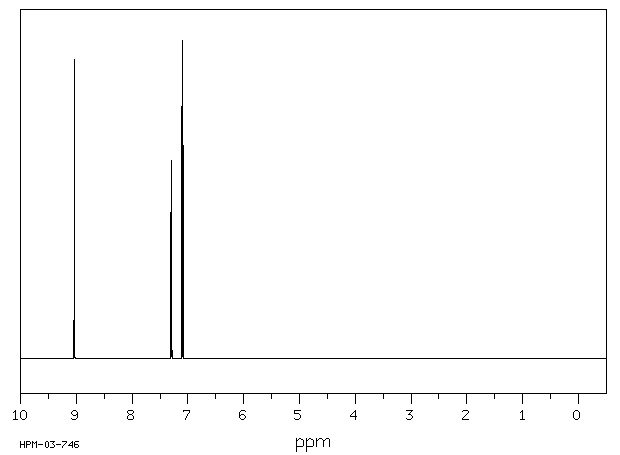2-碘噻吩-3-甲醛 | 18812-40-3
中文名称
2-碘噻吩-3-甲醛
中文别名
3-噻吩甲醛,2-碘-
英文名称
2-Iodothiophene-3-carbaldehyde
英文别名
2-iodo-3-formylthiophene;3-formyl-2-iodothiophene
CAS
18812-40-3
化学式
C5H3IOS
mdl
——
分子量
238.049
InChiKey
XQBBCHBIMBAUEN-UHFFFAOYSA-N
BEILSTEIN
——
EINECS
——
-
物化性质
-
计算性质
-
ADMET
-
安全信息
-
SDS
-
制备方法与用途
-
上下游信息
-
文献信息
-
表征谱图
-
同类化合物
-
相关功能分类
-
相关结构分类
计算性质
-
辛醇/水分配系数(LogP):1.8
-
重原子数:8
-
可旋转键数:1
-
环数:1.0
-
sp3杂化的碳原子比例:0.0
-
拓扑面积:45.3
-
氢给体数:0
-
氢受体数:2
安全信息
-
危险性防范说明:P261,P305+P351+P338
-
危险性描述:H302,H315,H319,H335
SDS
上下游信息
反应信息
-
作为反应物:描述:参考文献:名称:Novel Electron Acceptors Bearing a Heteroquinonoid System. 4. Syntheses, Properties, and Charge-Transfer Complexes of 2,7-Bis(dicyanomethylene)-2,7-dihydrobenzo[2,1-b:3,4-b']dithiophene, 2,7-Bis(dicyanomethylene)-2,7-dihydrobenzo[1,2-b:4,3-b']dithiophene, and 2,6-Bis(dicyanomethylene)-2,6-dihydrobenzo[1,2-b:4,5-b']dithiophene摘要:The three title compounds were prepared as novel hetero-TCNQ electron accepters comprising the quinonoid skeletons of different benzodithiophene types between two dicyanomethylene groups. On the basis of cyclic voltammetry, they have electron affinities comparable to or stronger than that of TCNQ. In addition, the extensive building blocks serve to induce the effective reduction of on-site coulombic repulsion. They thus behaved as superior electron accepters for forming electrically conductive charge-transfer complexes. In particular, 2,7-bis(dicyanomethylene)-2,7-dihydrobenzo-[2,1-b:3,4-b']dithiophene was the most tractable in terms of stability and solubility, giving a variety of conductive complexes with typical electron donors of TTT, TTF,and TPBP types. Most of these complexes showed a characteristic broad electronic transition in the infrared region of 2.9-4.0 kcm(-1), supporting the idea that their crystal structures assume a stacking form of segregated donor and acceptor columns with mixed valence states.DOI:10.1021/jo00090a027
-
作为产物:描述:(thiophen-3-ylmethylene)aniline 在 六氟磷酸钾 、 [RuCl2(benzene)]2 、 sodium hydroxide 、 水 、 碘 作用下, 以 乙腈 为溶剂, 反应 96.0h, 生成 2-碘噻吩-3-甲醛参考文献:名称:新型基于噻吩的环化化合物:合成,表征和反应性摘要:一系列之间的反应噻吩基与[(η亚胺6 -C 6 H ^ 6)的RuCl(μ-Cl)的] 2,在碱性介质中,并在MeCN给家庭化学计量的[Ru(C的ruthenacycles的∧ N)(NCMe)4 ] PF 6(C ∧N =正金属化的噻吩亚胺)。在这些物种中,CH活化过程在大多数情况下是在噻吩环上产生的。当两个CH键竞争时(噻吩与芳基),环金属化可以根据亚甲基C═N键的位置被区域选择性地驱动到噻吩单元或芳环上。根据杂环中亚胺的情况(分别为3或2),环金属化也可以定向到噻吩的2或3位。在所有研究的情况下,η 6 -C 6 H ^ 6配体被乙腈取代。已经确定了两种代表性复合物的X射线结构。这些基于噻吩的金属环在非常温和的条件下与碘反应,水解后得到取代的3-碘-2-甲酰基(苯并)噻吩或取代的2-碘-3-甲酰基(苯并)噻吩,作为有机金属前体的函数。DOI:10.1021/ic101946n
文献信息
-
Preparation and Regioselective Magnesiation or Lithiation of Bis(trimethylsilyl)methyl-Substituted Heteroaryls for the Generation of Highly Functionalized Heterocycles作者:Thomas Klatt、Veronika Werner、Marina G. Maximova、Dorian Didier、Yitzhak Apeloig、Paul KnochelDOI:10.1002/chem.201500627日期:2015.5.18A wide range of bis(trimethylsilyl)methyl (BTSM)‐ substituted heteroaryl derivatives has been prepared by using Kumada–Corriu or Negishi cross‐coupling reactions. The regioselective lithiation or magnesiation of these building blocks bearing a bulky BTSM group by using magnesium or lithium 2,2,6,6‐tetramethylpiperidide bases followed by quenching reactions with different electrophiles provides various
-
Simultaneous and Stereoselective Formation of Planar and Axial Chiralities in Enantiopure Sulfinyl Iron Diene Complexes作者:Robert S. Paley、Jane M. Liu、Bruce R. Lichtenstein、Vanessa L. Knoedler、Toby T. Sanan、Drew J. Adams、Jorge Fernández、Paul R. RablenDOI:10.1021/ol027306q日期:2003.2.1[reaction: see text] Enantiopure (1Z,3E)-1-sulfinyl dienes bearing an o-dithianylphenyl group can be prepared and complexed with (bda)Fe(CO)(3) to afford the corresponding sulfinyl diene iron(0) tricarbonyl complexes. This diastereoselective complexation introduces planar and axial chirality simultaneously, with a high degree of facial selectivity as well as atropselectivity. Dynamic kinetic resolution
-
[EN] INHIBITORS OF PURINE NUCLEOSIDE PHOSPHORYLASE - SYNTHESIS AND USE THEREOF FOR TREATMENT OF T-CELL ACUTE LYMPHOBLASTIC LEUKEMIA AND LYMPHOMA<br/>[FR] INHIBITEURS DE LA SYNTHÈSE DE LA PURINE NUCLÉOSIDE PHOSPHORYLASE ET LEUR UTILISATION POUR LE TRAITEMENT DE LA LEUCÉMIE LYMPHOBLASTIQUE AIGUË À LYMPHOCYTES T ET DU LYMPHOME申请人:USTAV ORGANICKE CHEMIE A BIOCHEMIE AV CR V V I公开号:WO2021083438A1公开(公告)日:2021-05-06The present invention relates to new compounds of general formula I, their synthesis, their pharmaceutically acceptable salts, and their use in treatment of T-cell acute lymphoblastic leukemia and lymphoma.本发明涉及一般式I的新化合物,它们的合成,它们的药学上可接受的盐,以及它们在T细胞急性淋巴细胞白血病和淋巴瘤治疗中的用途。
-
GRONOWITZ S .; DAHLGREN T., CHEM. SER., 1977, 12, NO 2-3, 57-67作者:GRONOWITZ S .、 DAHLGREN T.DOI:——日期:——
表征谱图
-
氢谱1HNMR
-
质谱MS
-
碳谱13CNMR
-
红外IR
-
拉曼Raman
-
峰位数据
-
峰位匹配
-
表征信息
同类化合物
(反式)-4-壬烯醛
(s)-2,3-二羟基丙酸甲酯
([1-(甲氧基甲基)-1H-1,2,4-三唑-5-基](苯基)甲酮)
(Z)-4-辛烯醛
(S)-氨基甲酸酯β-D-O-葡糖醛酸
(S)-3-(((2,2-二氟-1-羟基-7-(甲基磺酰基)-2,3-二氢-1H-茚满-4-基)氧基)-5-氟苄腈
(R)-氨基甲酸酯β-D-O-葡糖醛酸
(5,5-二甲基-2-(哌啶-2-基)环己烷-1,3-二酮)
(2,5-二氟苯基)-4-哌啶基-甲酮
龙胆苦苷
龙胆二糖甲乙酮氰醇(P)
龙胆二糖丙酮氰醇(P)
龙胆三糖
龙涎酮
齐罗硅酮
齐留通beta-D-葡糖苷酸
鼠李糖
黑芥子苷单钾盐
黑海棉酸钠盐
黑木金合欢素
黑曲霉三糖
黑介子苷
黄尿酸8-O-葡糖苷
麻西那霉素II
麦迪霉素
麦芽糖脎
麦芽糖基海藻糖
麦芽糖1-磷酸酯
麦芽糖
麦芽四糖醇
麦芽四糖
麦芽十糖
麦芽六糖
麦芽五糖水合物
麦芽五糖
麦芽五糖
麦芽五糖
麦芽三糖醇
麦芽三糖
麦芽三糖
麦芽三塘水合
麦芽七糖水合物
麦芽七糖
麦法朵
麦可酚酸-酰基-Β-D-葡糖苷酸
麦利查咪
麝香酮
鹤草酚
鸢尾酚酮 3-C-beta-D-吡喃葡萄糖苷
鸡矢藤苷







